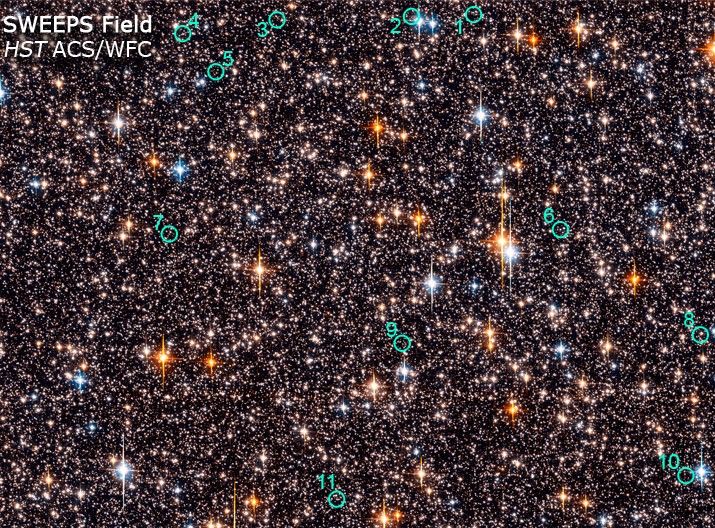Explanation: This crowded star field towards the center of our Milky Way Galaxy turns out to be a great place to search for planets beyond our solar system. In fact, repeatedly imaging about 180,000 stars in the field over a one week period, the Hubble Space Telescope enabled astronomers to conduct the Sagittarius Window Eclipsing Extrasolar Planet Search (SWEEPS). Their search looked for brief, periodic dips in brightness caused as a large planet eclipses or transits its parent star. Since chances of seeing such an eclipse are slim, it was a definite advantage to examine as many stars as possible. In the end, SWEEPS astronomers found 16 candidate stars (green circles identify 11 in this cropped picture) that are likely closely orbited by large Jupiter-sized planets with periods of a few days or less. Large planets orbiting so close to their stars are termed hot Jupiters. Kepler, a future NASA mission, is intended to extend the transit technique to search for Earth-sized planets.
1999 2000 2001 2002 2003 2004 2005 2006 2007 2008 2009 2010 2011 2012 2013 2014 2015 2016 2017 2018 2019 2020 2021 2022 2023 2024 2025 |
Январь Февраль Март Апрель Май Июнь Июль Август Сентябрь Октябрь Ноябрь Декабрь |
NASA Web Site Statements, Warnings, and Disclaimers
NASA Official: Jay Norris. Specific rights apply.
A service of: LHEA at NASA / GSFC
& Michigan Tech. U.
|
Публикации с ключевыми словами:
extrasolar planet - HST - transit - экзопланета - космический телескоп им.Хаббла - Прохождение
Публикации со словами: extrasolar planet - HST - transit - экзопланета - космический телескоп им.Хаббла - Прохождение | |
См. также:
Все публикации на ту же тему >> | |
Мнения читателей [7]
